Aerosol Evolution and Influencing Factor Analysis during Haze Periods in the Guanzhong Area of China Based on Multi-Source Data
Abstract
1. Introduction
2. Materials and Methods
2.1. Study Area
2.2. Research Process
2.3. Data
2.3.1. Remote Sensing Data
2.3.2. Global Data Assimilation System (GDAS) Data
2.3.3. Topography Data
2.3.4. Air Quality Data
2.3.5. Other Data
2.4. Methods
2.4.1. DT Method
2.4.2. HYSPLIT
2.4.3. Perceptual Hashing Algorithm (PHA)
- I.
- Resample the image to an 8 × 8 size, with 64 pixels in total. The purpose of this step is to eliminate differences in image size, scale, and resolution.
- II.
- Convert the reduced image to 64 grayscale images. The purpose of this step is to eliminate any differences between the images caused by the use of different color bands.
- III.
- Perform discrete cosine transform (DCT). Due to the strong “energy concentration” property of DCT, the energy of most natural signals (including sound, images, etc.) is concentrated in the low frequency part after DCT. After DCT transformation, the image becomes a 32 × 32 matrix.
- IV.
- DCT reduction. We only need to retain the 8 × 8 matrix in the top-left corner, which represents the lowest frequency in the image.
- V.
- The average of all 64 values is calculated. The 8 × 8 matrix and average are compared, and the 64-bit hash value is set to “1” if it is greater than or equal to the average and to “0” if it is less than the average.
- VI.
- The comparison results are set to a 64-bit string, which is the fingerprint of the image. Comparing fingerprints between images, a smaller number of different characters (Hamming distance) indicates a higher similarity.
3. Results and Analysis
3.1. Statistical Analysis of Air Quality Data
3.2. Classification of Haze Causes
3.3. AOD Spatial Distribution Characteristics and Influencing Factor Analysis
3.4. Characteristics of AOD Changes over Time and Analysis of Natural Factors
3.4.1. Wind Speed
3.4.2. Wind Direction
3.4.3. Precipitation
4. Conclusions
- (1)
- According to AQI and air mass trajectory, the haze period is divided into locally generated and externally transported. It was determined that 94.7% of the haze was locally generated haze in Guanzhong.
- (2)
- The AOD of the Guanzhong area was higher in winter (0.39) and spring (0.37) and lower in summer (0.20) and autumn (0.14). The spatial distribution of AOD was high in the central and eastern areas and low in the rest of the areas.
- (3)
- By comparing the Hamming distance, it was concluded that the aerosol spatial distribution in the study area was most strongly correlated with the following factors: GDP > population density > topography.
- (4)
- The significant increase in AOD was mainly caused by low wind speed, whereas the significant decrease was mainly caused by high wind speed and precipitation. When air quality improves, the wind direction is mostly from the west. The Pearson r between wind speed and AOD change was −0.63, and between precipitation and AOD change it was −0.66, both of which showed strong negative correlations.
Author Contributions
Funding
Institutional Review Board Statement
Informed Consent Statement
Data Availability Statement
Conflicts of Interest
References
- Chu, Y.; Liu, Y.; Li, X.; Liu, Z.; Lu, H.; Lu, Y.; Mao, Z.; Chen, X.; Li, N.; Ren, M.; et al. A review on predicting ground PM2.5 concentration using satellite aerosol optical depth. Atmosphere 2016, 7, 129. [Google Scholar] [CrossRef]
- Du, H.; Li, J.; Chen, X.; Wang, Z.; Sun, Y.; Fu, P.; Li, J.; Gao, J.; Wei, Y. Modeling of aerosol property evolution during Winter Haze episodes over a megacity cluster in northern China: Roles of regional transport and heterogeneous reactions of SO2. Atmos. Chem. Phys. 2019, 19, 9351–9370. [Google Scholar] [CrossRef]
- Pan, X.; Uno, I.; Wang, Z.; Nishizawa, T.; Sugimoto, N.; Yamamoto, S.; Kobayashi, H.; Sun, Y.; Fu, P.; Tang, X.; et al. Real-time observational evidence of changing Asian dust morphology with the mixing of heavy anthropogenic pollution. Sci. Rep. 2017, 7, 335. [Google Scholar] [CrossRef] [PubMed]
- Park, Y.; Kwon, B.; Heo, J.; Hu, X.; Liu, Y.; Moon, T. Estimating PM2.5 concentration of the conterminous United States via interpretable convolutional Neural Networks. Environ. Pollut. 2020, 256, 113395. [Google Scholar] [CrossRef] [PubMed]
- Shin, M.; Kang, Y.; Park, S.; Im, J.; Yoo, C.; Quackenbush, L.J. Estimating ground-level particulate matter concentrations using satellite-based data: A Review. GISci. Remote Sens. 2019, 57, 174–189. [Google Scholar] [CrossRef]
- Virtanen, T.H.; Kolmonen, P.; Sogacheva, L.; Rodríguez, E.; Saponaro, G.; de Leeuw, G. Collocation mismatch uncertainties in satellite aerosol retrieval validation. Atmos. Meas. Tech. 2018, 11, 925–938. [Google Scholar] [CrossRef]
- Cravero, C.; Marsano, D. Simulation of COVID-19 indoor emissions from coughing and breathing with air conditioning and mask protection effects. Indoor Built Environ. 2022, 31, 1242–1261. [Google Scholar] [CrossRef]
- Giles, D.M.; Sinyuk, A.; Sorokin, M.G.; Schafer, J.S.; Smirnov, A.; Slutsker, I.; Eck, T.F.; Holben, B.N.; Lewis, J.R.; Campbell, J.R.; et al. Advancements in the aerosol robotic network (aeronet) version 3 database—automated near-real-time quality control algorithm with improved cloud screening for Sun Photometer Aerosol Optical depth (AOD) measurements. Atmos. Meas. Tech. 2019, 12, 169–209. [Google Scholar] [CrossRef]
- Yang, Y.; Fan, S.; Wang, L.; Gao, Z.; Zhang, Y.; Zou, H.; Miao, S.; Li, Y.; Huang, M.; Yim, S.H.; et al. Diurnal evolution of the wintertime boundary layer in urban Beijing, China: Insights from Doppler Lidar and a 325-M Meteorological Tower. Remote Sens. 2020, 12, 3935. [Google Scholar] [CrossRef]
- Zhang, M.; Su, B.; Bilal, M.; Atique, L.; Usman, M.; Qiu, Z.; Ali, M.A.; Han, G. An investigation of vertically distributed aerosol optical properties over Pakistan using CALIPSO satellite data. Remote Sens. 2020, 12, 2183. [Google Scholar] [CrossRef]
- Chen, X.; de Leeuw, G.; Arola, A.; Liu, S.; Liu, Y.; Li, Z.; Zhang, K. Joint retrieval of the aerosol fine mode fraction and optical depth using MODIS spectral reflectance over northern and eastern China: Artificial Neural Network Method. Remote Sens. Environ. 2020, 249, 112006. [Google Scholar] [CrossRef]
- Montas, L.; Roy, S.S.; Ferguson, A.C.; Mena, K.D.; Kumar, N.; Solo-Gabriele, H.M. Using satellite-based AOD and ground-based measurements to evaluate the impact of the DWH oil spill on Coastal Air Quality. Mar. Pollut. Bull. 2022, 181, 113910. [Google Scholar] [CrossRef] [PubMed]
- Park, S.S.; Kim, S.-W.; Song, C.-K.; Park, J.-U.; Bae, K.-H. Spatio-temporal variability of aerosol optical depth, total ozone and NO2 over East Asia: Strategy for the validation to the GEMS Scientific Products. Remote Sens. 2020, 12, 2256. [Google Scholar] [CrossRef]
- Shao, M.; Wu, L.; Li, F.; Lin, C. Spatiotemporal dynamics of ecosystem services and the driving factors in urban agglomerations: Evidence from 12 National Urban Agglomerations in China. Front. Ecol. Evol. 2022, 10, 804969. [Google Scholar] [CrossRef]
- Che, H.; Yang, L.; Liu, C.; Xia, X.; Wang, Y.; Wang, H.; Wang, H.; Lu, X.; Zhang, X. Long-term validation of Modis C6 and C6.1 dark target aerosol products over China using CARSNET and aeronet. Chemosphere 2019, 236, 124268. [Google Scholar] [CrossRef]
- Mancilla, Y.; Hernandez Paniagua, I.Y.; Mendoza, A. Spatial differences in ambient coarse and fine particles in the Monterrey metropolitan area, Mexico: Implications for source contribution. J. Air Waste Manag. Assoc. 2019, 69, 548–564. [Google Scholar] [CrossRef]
- Berhane, S.A.; Bu, L. Aerosol—Cloud interaction with summer precipitation over major cities in Eritrea. Remote Sens. 2021, 13, 677. [Google Scholar] [CrossRef]
- Gao, Y.; Zhang, M. Modeling study on seasonal variation in aerosol extinction properties over China. J. Environ. Sci. 2014, 26, 97–109. [Google Scholar] [CrossRef] [PubMed]
- Han, L.; Zhou, W.; Zhao, X.; Li, W.; Qian, Y. Comparing ground operation-measured and remotely sensed fine-particulate matter data: A case to validate the Dalhousie product in China. IEEE Geosci. Remote Sens. Mag. 2019, 7, 20–28. [Google Scholar] [CrossRef]
- Frank, T.D.; Di Girolamo, L.; Geegan, S. The spatial and temporal variability of aerosol optical depths in the Mojave Desert of Southern California. Remote Sens. Environ. 2007, 107, 54–64. [Google Scholar] [CrossRef]
- Barik, G.; Acharya, P.; Maiti, A.; Gayen, B.K.; Bar, S.; Sarkar, A. A synergy of linear model and wavelet analysis towards space-time characterization of Aerosol Optical Depth (AOD) during pre-monsoon season (2007–2016) over Indian sub-continent. J. Atmos. Sol.-Terr. Phys. 2020, 211, 105478. [Google Scholar] [CrossRef]
- Li, J.; Ge, X.; He, Q.; Abbas, A. Aerosol Optical Depth (AOD): Spatial and temporal variations and association with meteorological covariates in Taklimakan Desert, China. PeerJ 2021, 9, e10542. [Google Scholar] [CrossRef] [PubMed]
- Chen, A.; Yang, J.; He, Y.; Yuan, Q.; Li, Z.; Zhu, L. High spatiotemporal resolution estimation of AOD from himawari-8 using an ensemble machine learning gap-filling method. Sci. Total Environ. 2023, 857, 159673. [Google Scholar] [CrossRef] [PubMed]
- He, J.; Zha, Y.; Zhang, J.; Gao, J.; Li, Y.; Chen, X. Retrieval of aerosol optical thickness from HJ-1 CCD data based on Modis-derived surface reflectance. Int. J. Remote Sens. 2015, 36, 882–898. [Google Scholar] [CrossRef]
- Musonda, B.; Jing, Y.; Nyasulu, M.; Libanda, B. Long-term spatial and temporal variations of aerosol optical depth during 2000–2020 over Zambia, southcentral Africa. Air Qual. Atmos. Health 2021, 15, 177–193. [Google Scholar] [CrossRef]
- Zheng, Y.; Wang, X.; Zhang, X.; Hu, G. Multi-spatiotemporal patterns of aerosol optical depth and influencing factors during 2000–2020 from two spatial perspectives: The entire Yellow River Basin region and its urban agglomerations. Int. J. Appl. Earth Obs. Geoinf. 2022, 106, 102643. [Google Scholar] [CrossRef]
- Tan, Y.; Wang, Q.; Zhang, Z. Assessing spatiotemporal variations of AOD in Japan based on himawari-8 L3 V31 aerosol products: Validations and applications. Atmos. Pollut. Res. 2022, 13, 101439. [Google Scholar] [CrossRef]
- Li, K.; Bai, K.; Li, Z.; Guo, J.; Chang, N.-B. Synergistic Data Fusion of multimodal AOD and air quality data for near real-time full coverage air pollution assessment. J. Environ. Manag. 2022, 302, 114121. [Google Scholar] [CrossRef] [PubMed]
- Ettehadi Osgouei, P.; Roberts, G.; Kaya, S.; Bilal, M.; Dash, J.; Sertel, E. Evaluation and comparison of Modis and Viirs Aerosol Optical Depth (AOD) products over regions in the Eastern Mediterranean and the Black Sea. Atmos. Environ. 2022, 268, 118784. [Google Scholar] [CrossRef]
- Falah, S.; Mhawish, A.; Sorek-Hamer, M.; Lyapustin, A.I.; Kloog, I.; Banerjee, T.; Kizel, F.; Broday, D.M. Impact of environmental attributes on the uncertainty in Maiac/Modis AOD retrievals: A comparative analysis. Atmos. Environ. 2021, 262, 118659. [Google Scholar] [CrossRef]
- Pinder, R.W.; Klopp, J.M.; Kleiman, G.; Hagler, G.S.W.; Awe, Y.; Terry, S. Opportunities and challenges for filling the air quality data gap in low- and middle-income countries. Atmos. Environ. 2019, 215, 116794. [Google Scholar] [CrossRef] [PubMed]
- Remer, L.A. Validation of modis aerosol retrieval over Ocean. Geophys. Res. Lett. 2002, 29, 1618. [Google Scholar] [CrossRef]
- Aparicio, G.; Gerardino, M.P.; Rangel, M.A. Gender gaps in birth weight across Latin America: Evidence on the role of Air Pollution. J. Econ. Race Policy 2019, 2, 202–224. [Google Scholar] [CrossRef]
- Zaman, S.U.; Pavel, M.R.; Joy, K.S.; Jeba, F.; Islam, M.S.; Paul, S.; Bari, M.A.; Salam, A. Spatial and temporal variation of aerosol optical depths over six major cities in Bangladesh. Atmos. Res. 2021, 262, 105803. [Google Scholar] [CrossRef]
- Aldegunde, J.A.A.; Sanchez, A.F.; Saba, M.; Bolanos, E.Q.; Palenque, J.U. Analysis of PM2.5 and Meteorological Variables Using Enhanced Geospatial Techniques in Developing Countries: A Case Study of Cartagena de Indias City (Colombia). Atmosphere 2022, 13, 506. [Google Scholar] [CrossRef]
- Pham, H.T.; Marshall, L.; Johnson, F.; Sharma, A. A method for combining SRTM DEM and Aster GDEM2 to improve topography estimation in regions without reference data. Remote Sens. Environ. 2018, 210, 229–241. [Google Scholar] [CrossRef]
- Fernandez-Martinez, M.; Yu, R.; Gamon, J.; Hmimina, G.; Filella, I.; Balzarolo, M.; Stocker, B.; Peñuelas, J. Monitoring spatial and temporal variabilities of gross primary production using MAIAC MODIS data. Remote Sens. 2019, 11, 874. [Google Scholar] [CrossRef]
- Mhawish, A.; Banerjee, T.; Sorek-Hamer, M.; Lyapustin, A.; Broday, D.M.; Chatfield, R. Comparison and evaluation of Modis multi-angle implementation of atmospheric correction (MAIAC) aerosol product over South Asia. Remote Sens. Environ. 2019, 224, 12–28. [Google Scholar] [CrossRef]
- Kaufman, Y.J.; Tanre, D.; Gordon, H.R.; Nakajima, T.; Lenoble, J.; Frouin, R.; Grassl, H.; Herman, B.M.; King, M.D.; Teillet, P.M. Passive remote sensing of tropospheric aerosol and atmospheric correction for the aerosol effect. J. Geophys. Res. Atmos. 1997, 102, 16815–16830. [Google Scholar] [CrossRef]
- Kaufman, Y.J.; Wald, A.E.; Remer, L.A.; Gao, B.-C.; Li, R.-R.; Flynn, L. The Modis 2.1-ΜM channel-correlation with visible reflectance for use in remote sensing of aerosol. IEEE Trans. Geosci. Remote Sens. 1997, 35, 1286–1298. [Google Scholar] [CrossRef]
- Vermote, E.F.; Tanre, D.; Deuze, J.L.; Herman, M.; Morcette, J.-J. Second simulation of the satellite signal in the solar spectrum, 6s: An overview. IEEE Trans. Geosci. Remote Sens. 1997, 35, 675–686. [Google Scholar] [CrossRef]
- Stein, A.F.; Draxler, R.R.; Rolph, G.D.; Stunder, B.J.; Cohen, M.D.; Ngan, F. NOAA’s Hysplit Atmospheric Transport and dispersion modeling system. Bull. Amer. Meteorol. Soc. 2015, 96, 2059–2077. [Google Scholar] [CrossRef]
- Chai, T.; Crawford, A.; Stunder, B.; Pavolonis, M.J.; Draxler, R.; Stein, A. Improving volcanic ash predictions with the hysplit dispersion model by assimilating Modis satellite retrievals. Atmos. Chem. Phys. 2017, 17, 2865–2879. [Google Scholar] [CrossRef]
- Ding, K.; Liu, Y.; Xu, Q.; Lu, F. A subject-sensitive perceptual hash based on mum-net for the integrity authentication of High Resolution Remote Sensing Images. ISPRS Int. J. Geo-Inf. 2020, 9, 485. [Google Scholar] [CrossRef]
- Farid, H. An overview of perceptual hashing. J. Online Trust. Saf. 2021, 1, 1–22. [Google Scholar] [CrossRef]
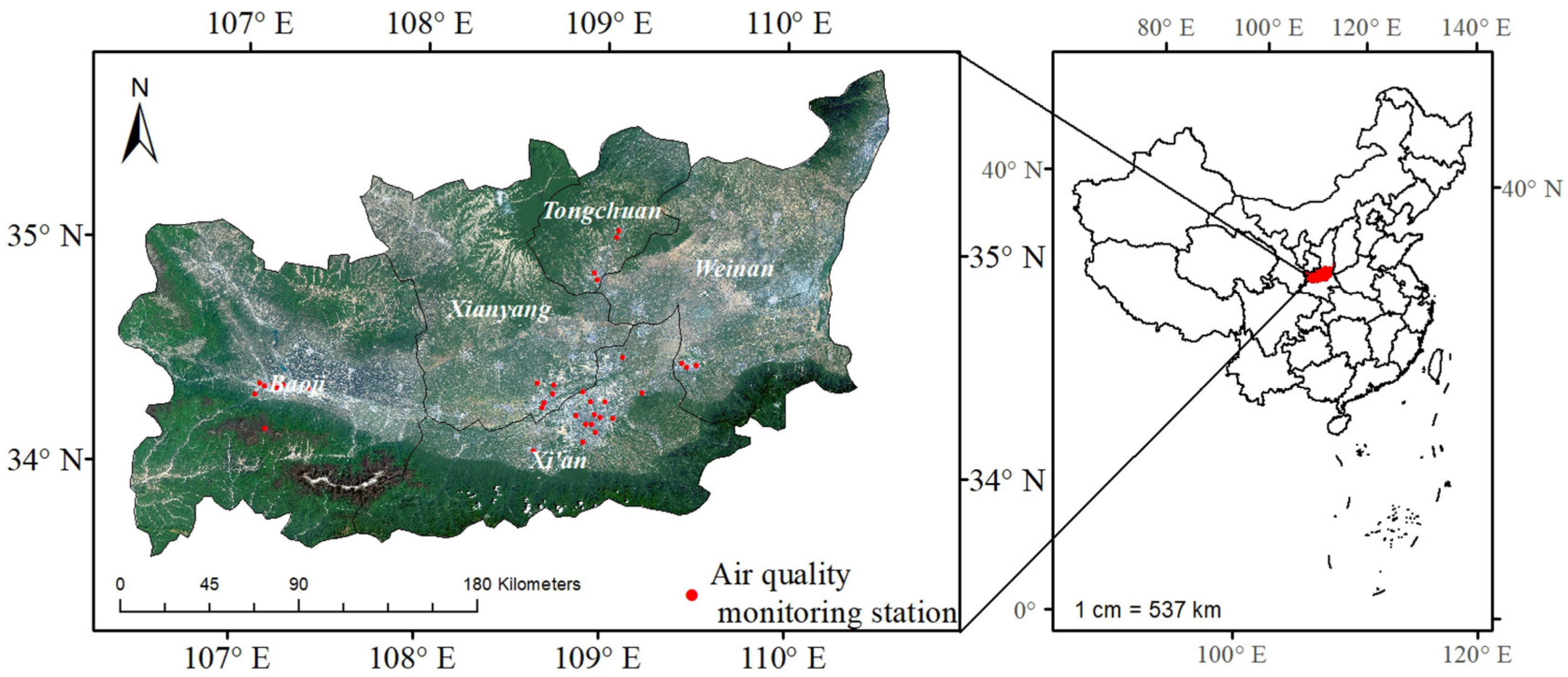

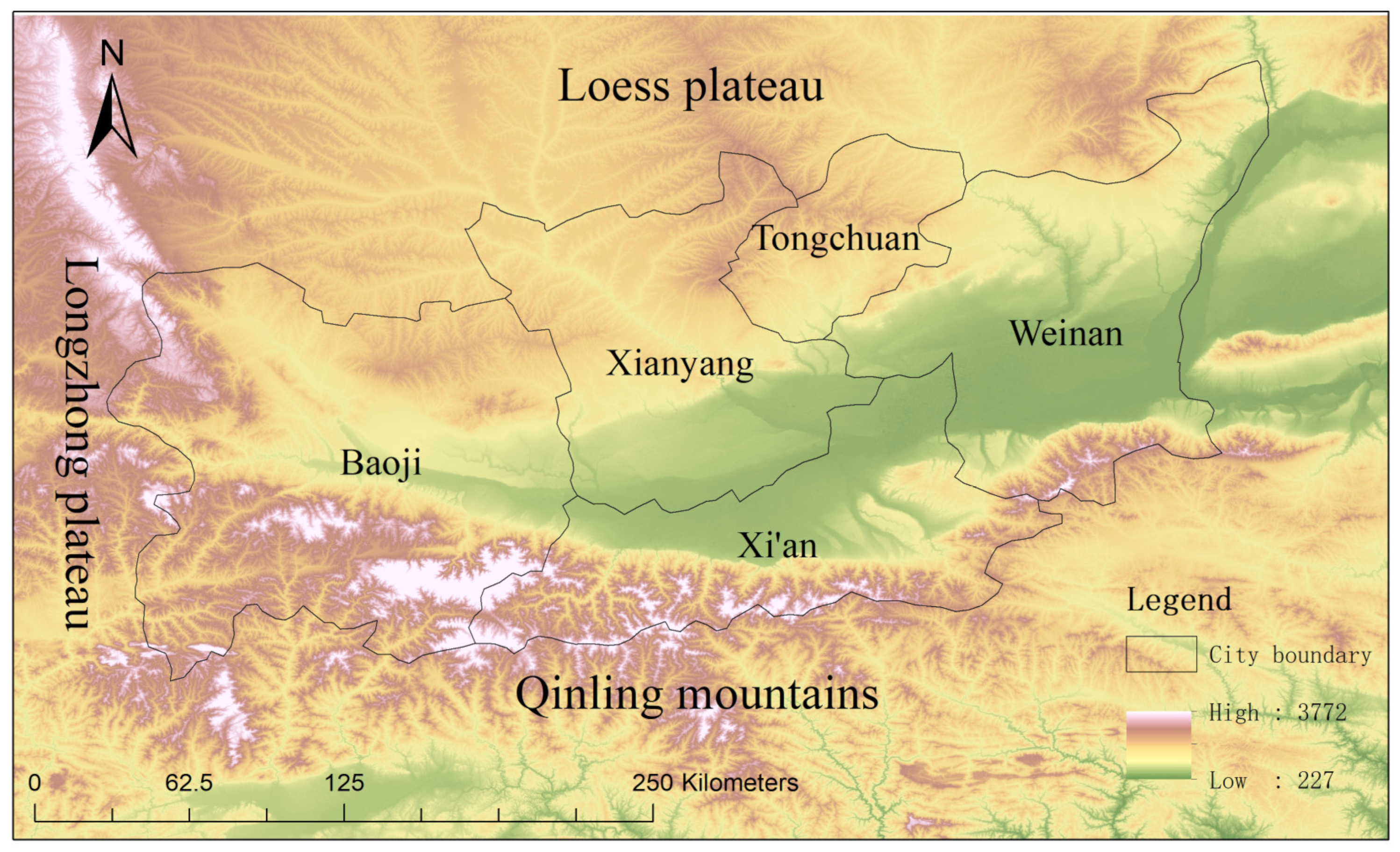
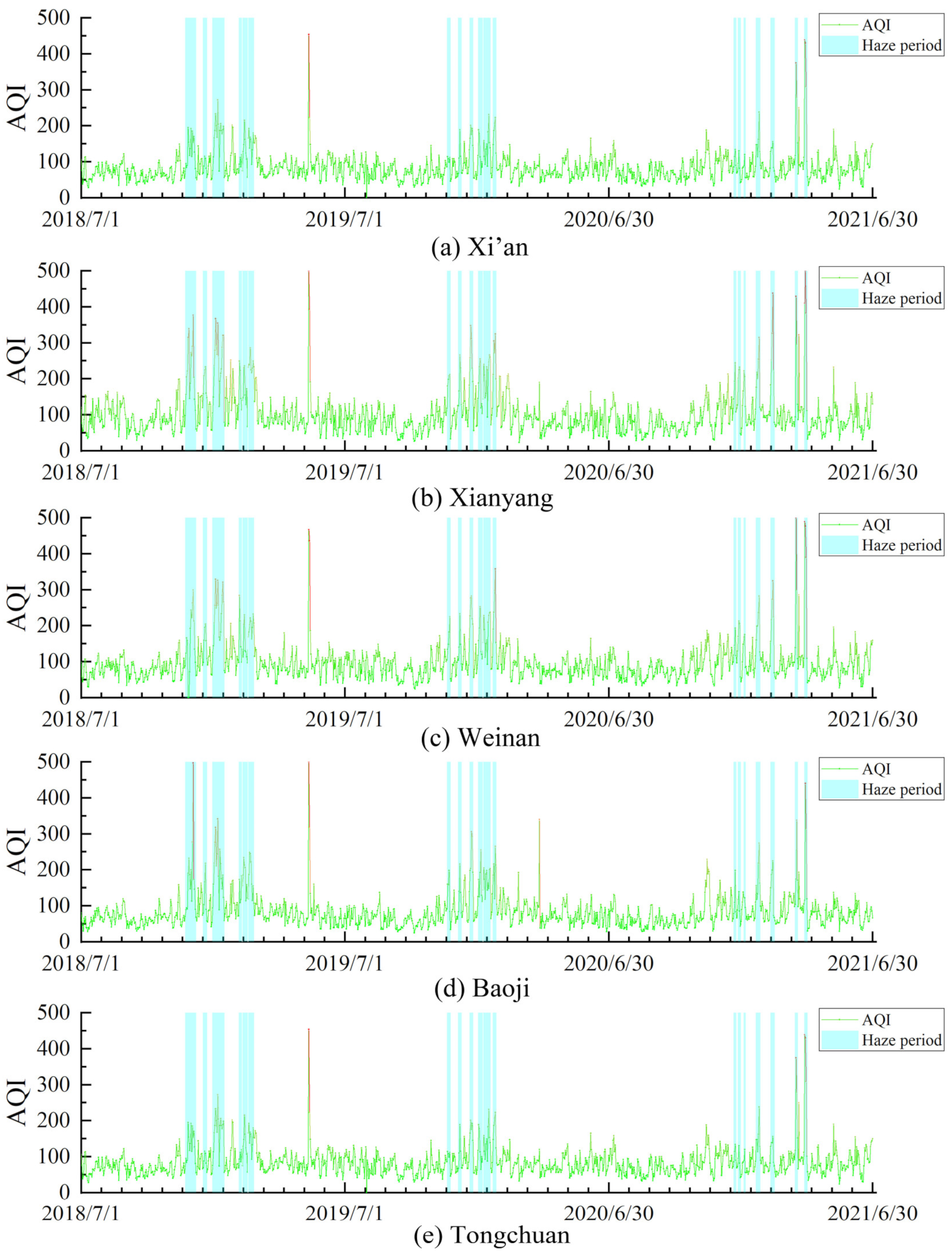
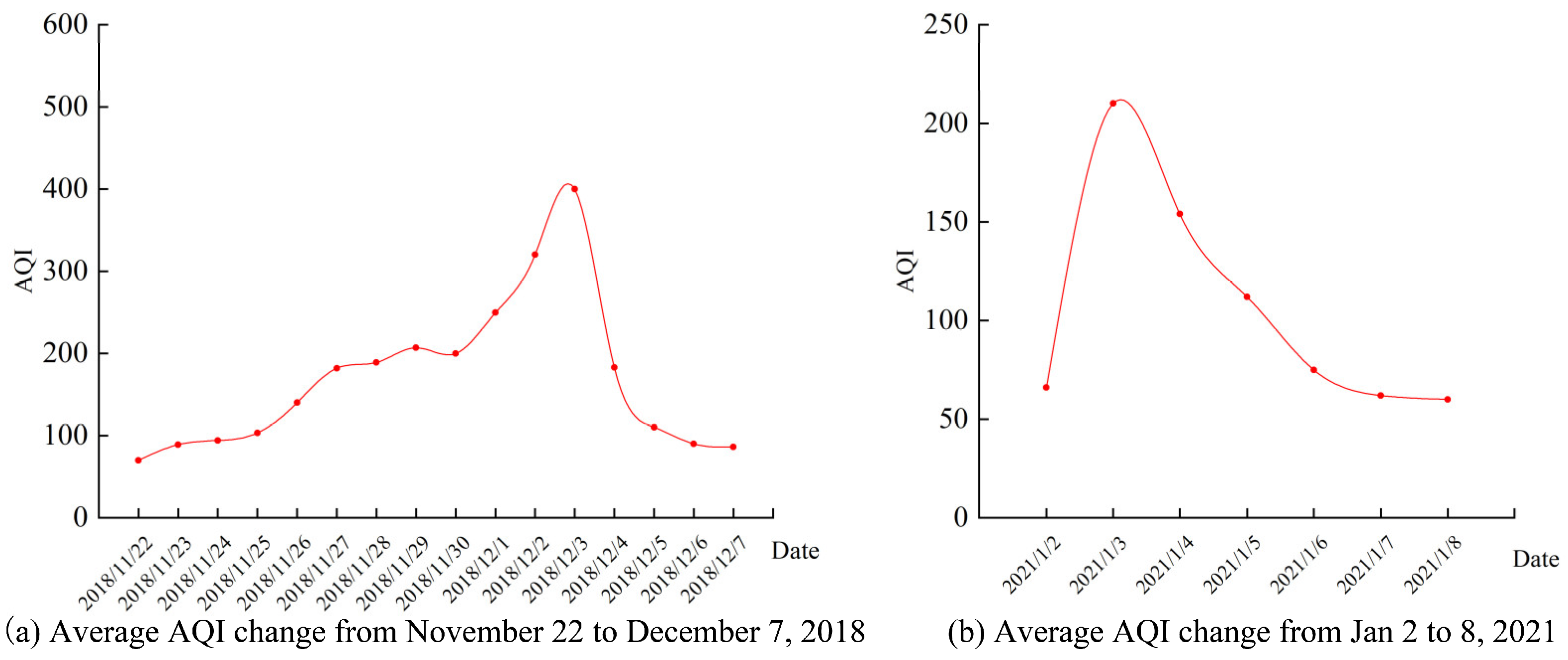
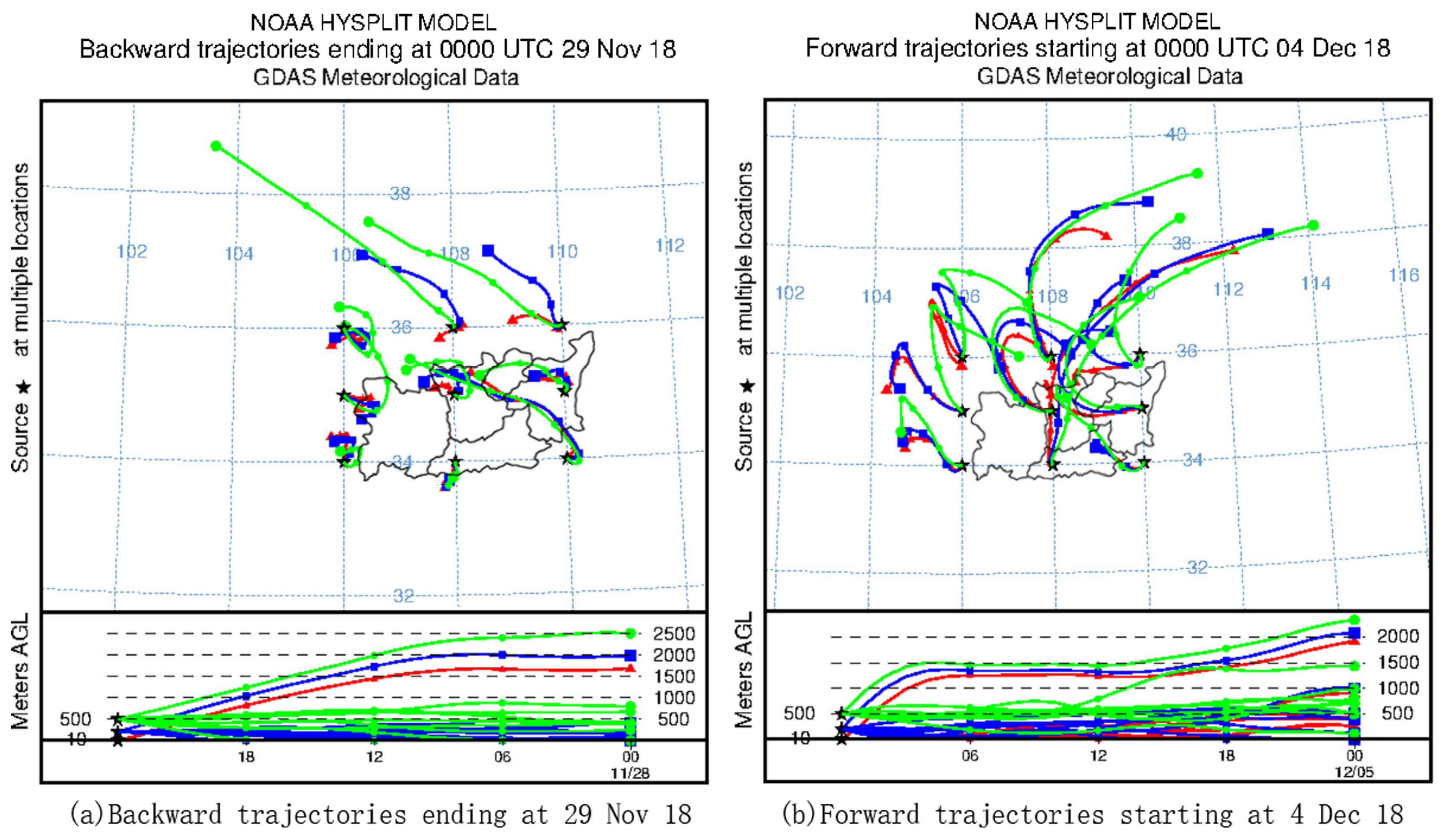
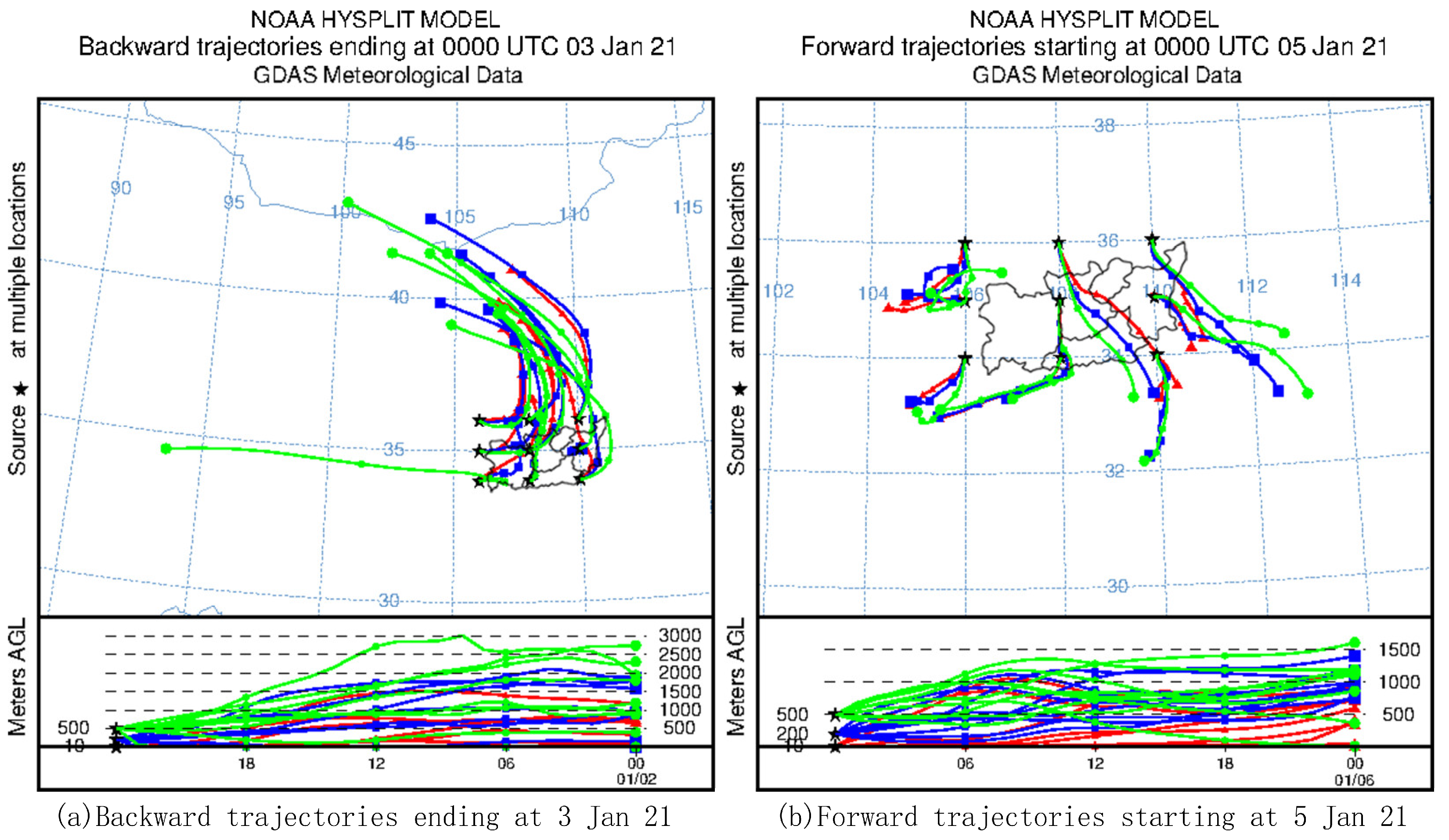
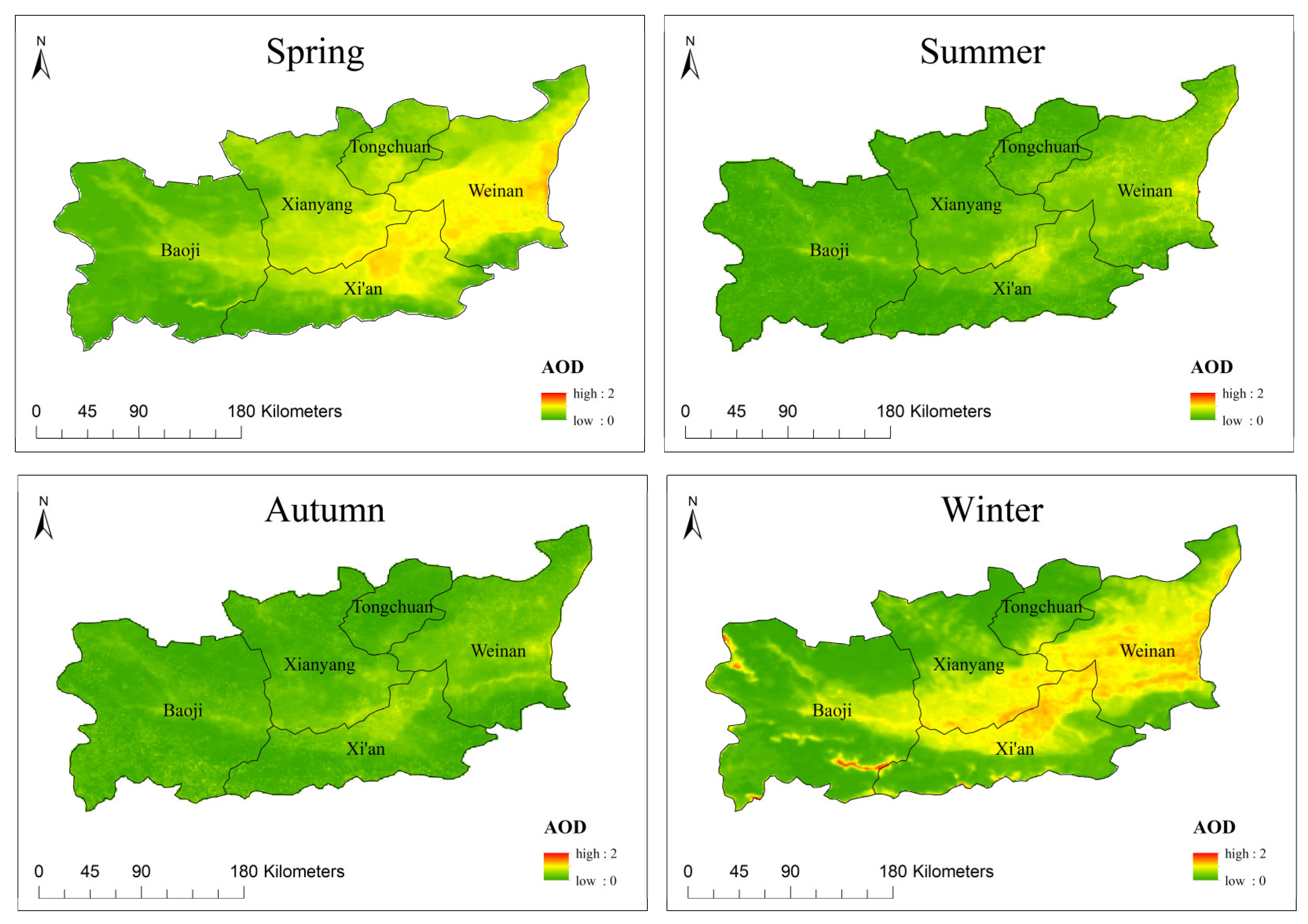
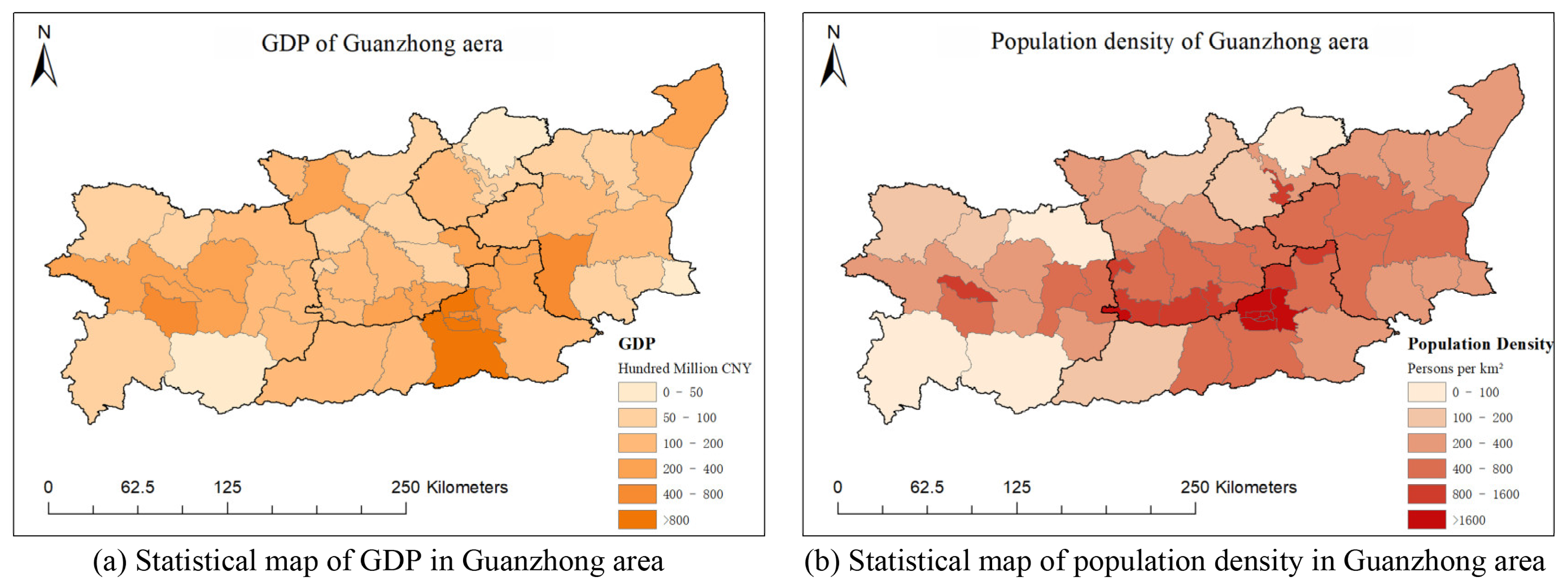

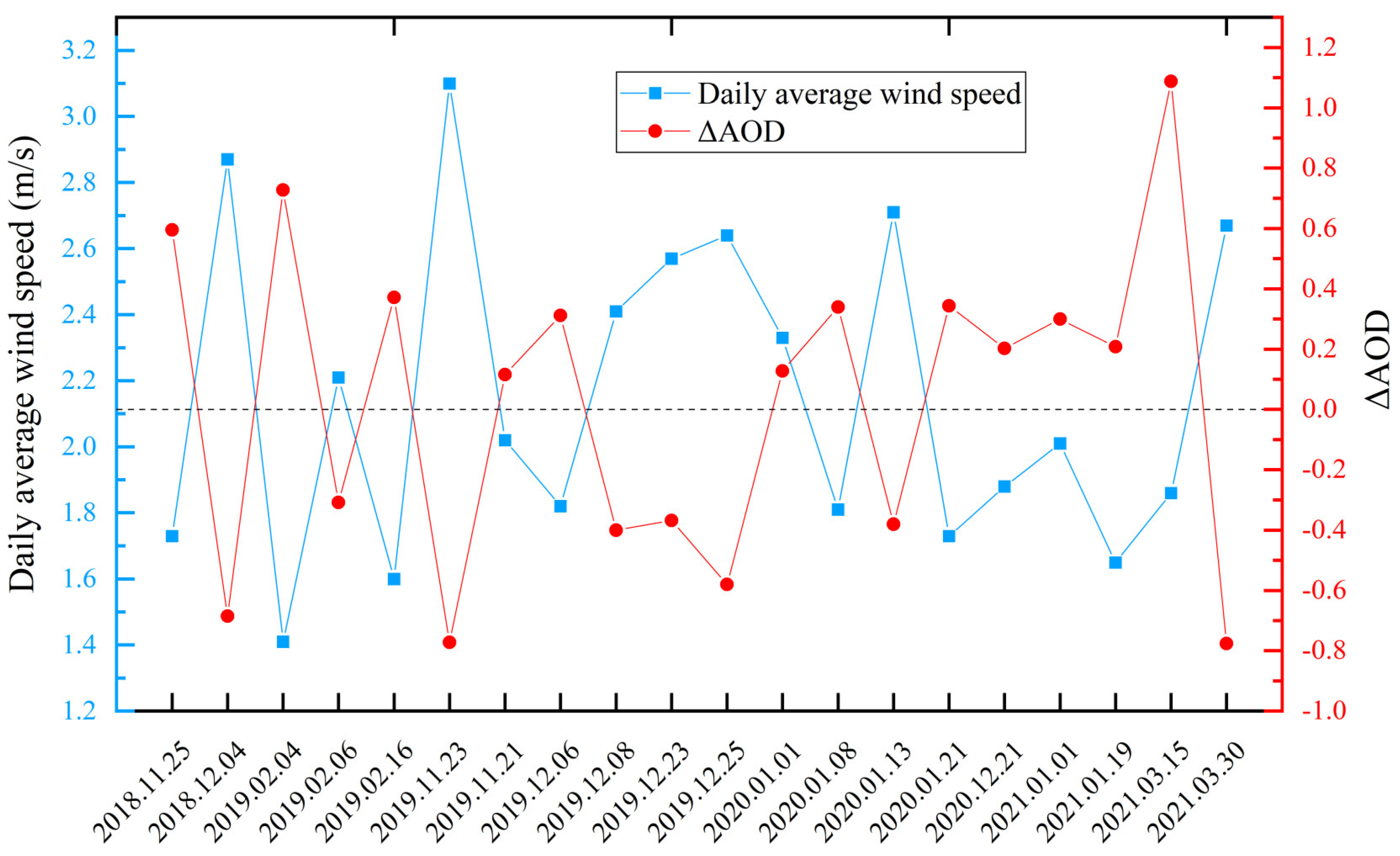
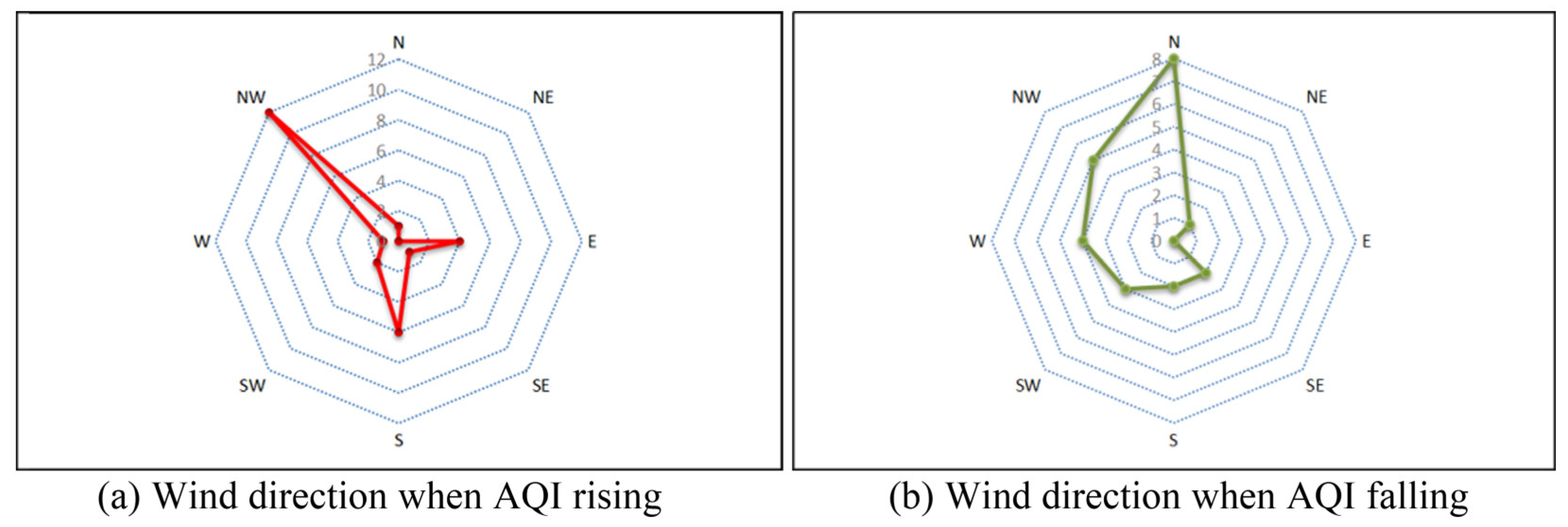
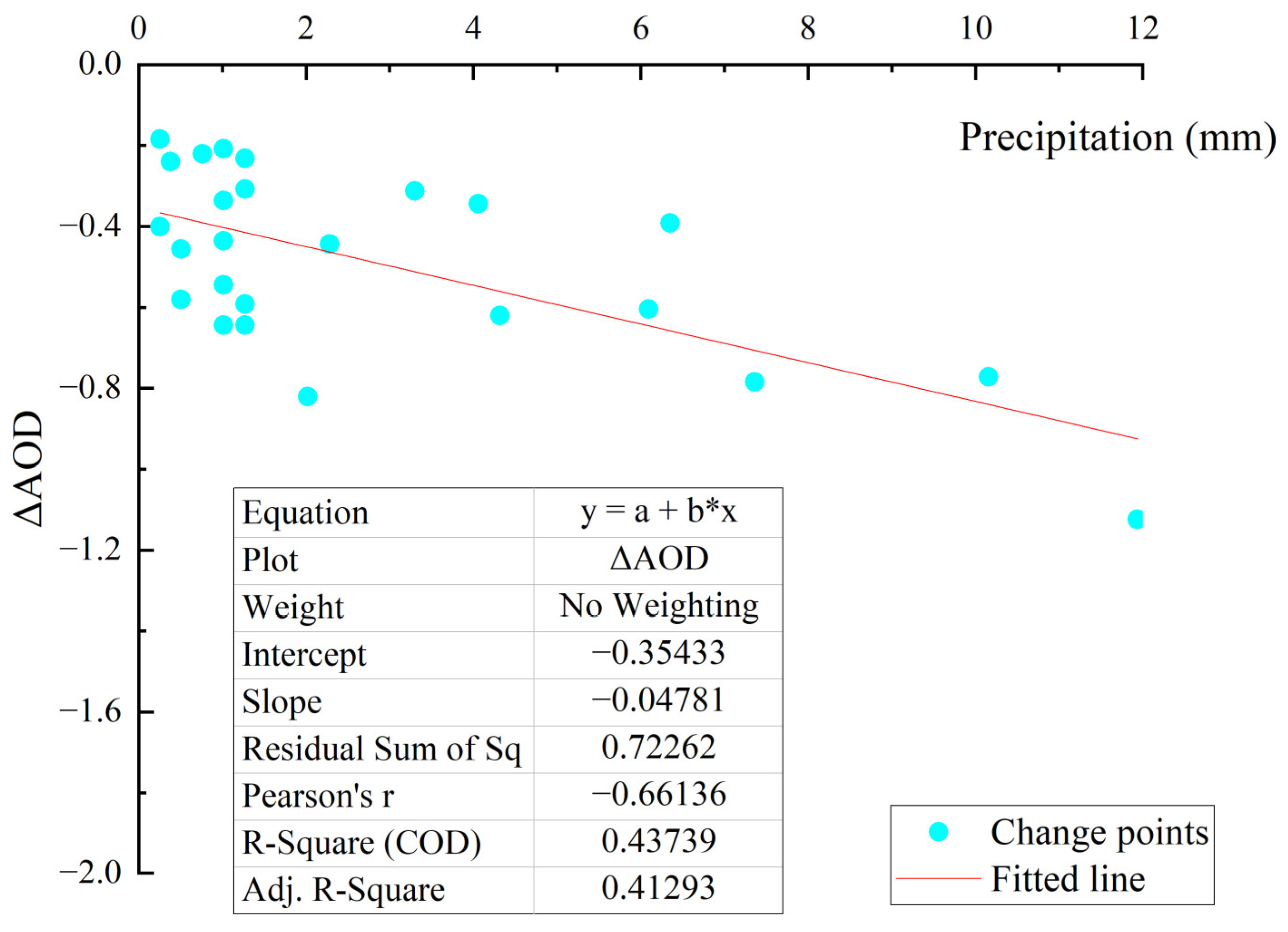
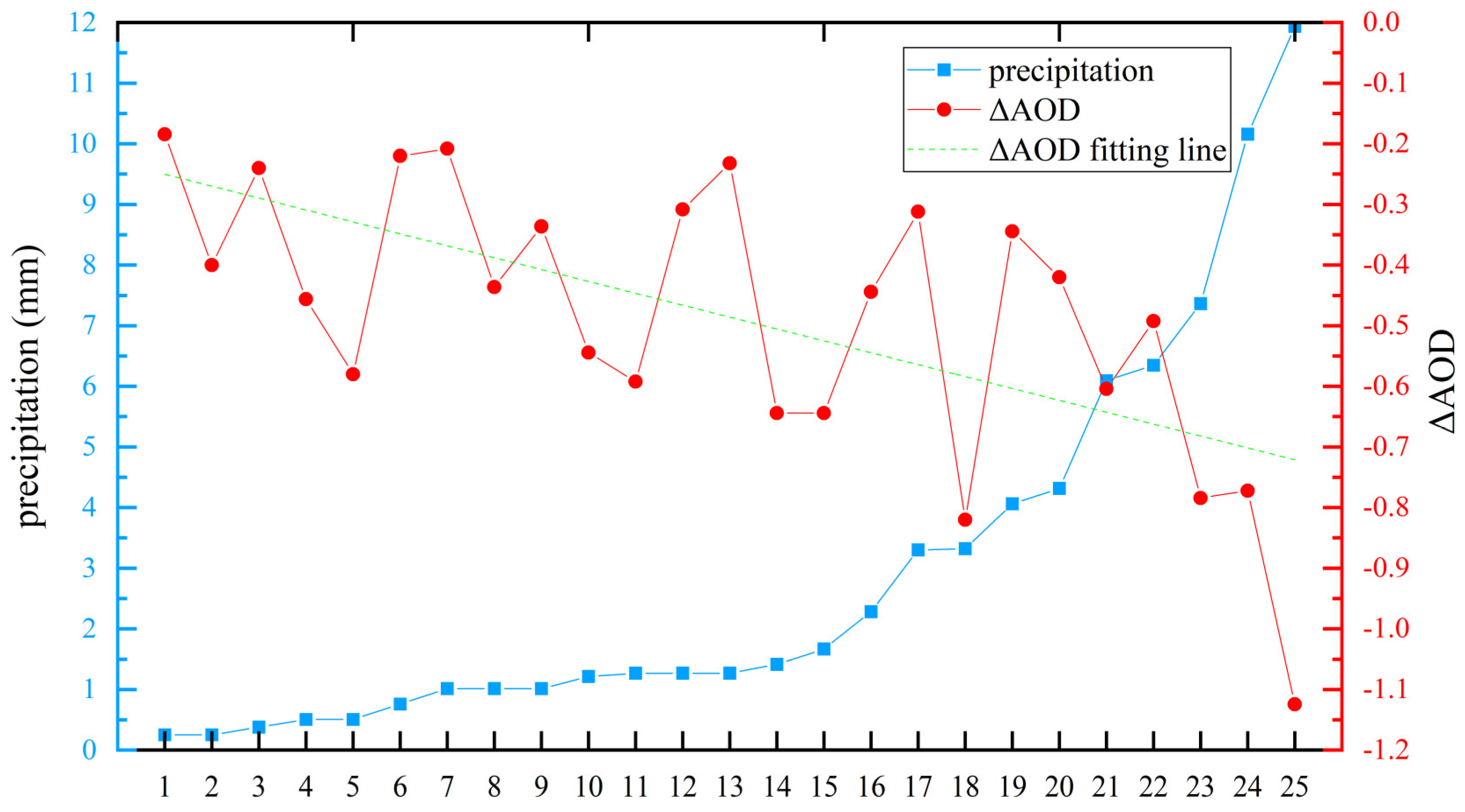
| Start Year | Duration | Days | Maximum AQI | Average AQI | Times (Average Days) |
|---|---|---|---|---|---|
| 2018 | 11.22–12.7 | 16 | 497 (Baoji on 12.3) | 172 | 3 (13.7 days) |
| 12.16–12.22 | 7 | 234 (Xi’an on 12.20) | 133 | ||
| 12.29–1.15 | 18 | 367 (Xianyang on 1.3) | 202 | ||
| 2019 | 2.4–2.8 | 5 | 284 (Xi’an on 2.5) | 143 | 6 (6.7 days) |
| 2.9–2.16 | 8 | 236 (Xianyang on 2.12) | 151 | ||
| 2.17–2.25 | 9 | 286 (Xianyang on 2.20) | 188 | ||
| 11.19–11.24 | 6 | 231 (Xi’an on 11.23) | 133 | ||
| 12.4–12.9 | 6 | 266 (Xianyang on 12.7) | 135 | ||
| 12.20–12.25 | 6 | 348 (Xianyang on 12.22) | 223 | ||
| 2020 | 1.1–1.7 | 7 | 255 (Xianyang on 1.4, Baoji on 1.5) | 151 | 5 (6.8 days) |
| 1.8–1.18 | 11 | 266 (Xianyang on 1.17) | 177 | ||
| 1.21–1.26 | 6 | 358 (Weinan on 1.25) | 207 | ||
| 12.19–12.23 | 5 | 244 (Xianyang on 12.22) | 126 | ||
| 12.25–12.29 | 5 | 232 (Xianyang on 12.28) | 128 | ||
| 2021 | 1.2–1.5 | 4 | 222 (Xianyang on 1.3) | 141 | 5 (5.6 days) |
| 1.19–1.25 | 7 | 315 (Xianyang on 1.24) | 177 | ||
| 2.8–2.14 | 7 | 438 (Xianyang on 2.12) | 173 | ||
| 3.14–3.18 | 5 | 500 (Weinan on 3.16) | 199 | ||
| 3.27–3.31 | 5 | 500 (Xi’an and Xianyang on 3.29) | 280 |
| Type | Air Mass Trajectory Characteristics | Variation Characteristics of AQI |
|---|---|---|
| locally generated | Trajectory of the air mass is very short and migration ability is limited, as shown in Figure 6a. | Maximum AQI is generally produced in the middle or end of the haze. Then, AQI rapidly decreases to a low level, as shown in Figure 5a. |
| External transport | Air masses are transported from distant areas over long distances, as shown in Figure 7a. | The AQI abruptly reaches the maximum value in the early stage of haze and then slowly decreases day by day, as shown in Figure 5b. |
| Influencing Factors | GDP | Population density | Topography |
|---|---|---|---|
| Hamming distance | 8 | 13 | 18 |
Publisher’s Note: MDPI stays neutral with regard to jurisdictional claims in published maps and institutional affiliations. |
© 2022 by the authors. Licensee MDPI, Basel, Switzerland. This article is an open access article distributed under the terms and conditions of the Creative Commons Attribution (CC BY) license (https://creativecommons.org/licenses/by/4.0/).
Share and Cite
Zhong, Y.; Kong, J.; Jiang, Y.; Zhang, Q.; Ma, H.; Wang, X. Aerosol Evolution and Influencing Factor Analysis during Haze Periods in the Guanzhong Area of China Based on Multi-Source Data. Atmosphere 2022, 13, 1975. https://doi.org/10.3390/atmos13121975
Zhong Y, Kong J, Jiang Y, Zhang Q, Ma H, Wang X. Aerosol Evolution and Influencing Factor Analysis during Haze Periods in the Guanzhong Area of China Based on Multi-Source Data. Atmosphere. 2022; 13(12):1975. https://doi.org/10.3390/atmos13121975
Chicago/Turabian StyleZhong, Yanling, Jinling Kong, Yizhu Jiang, Qiutong Zhang, Hongxia Ma, and Xixuan Wang. 2022. "Aerosol Evolution and Influencing Factor Analysis during Haze Periods in the Guanzhong Area of China Based on Multi-Source Data" Atmosphere 13, no. 12: 1975. https://doi.org/10.3390/atmos13121975
APA StyleZhong, Y., Kong, J., Jiang, Y., Zhang, Q., Ma, H., & Wang, X. (2022). Aerosol Evolution and Influencing Factor Analysis during Haze Periods in the Guanzhong Area of China Based on Multi-Source Data. Atmosphere, 13(12), 1975. https://doi.org/10.3390/atmos13121975






